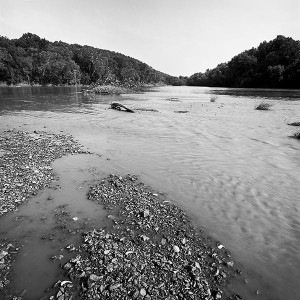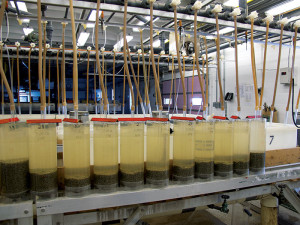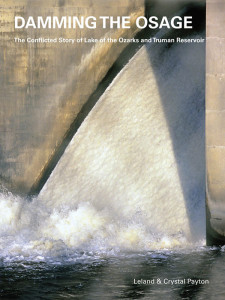
Paddlefish have not been spawning naturally on gravel bars like this in the Osage River since Truman Dam closed almost forty years ago.
The monthly feature, “What is it?” in the March issue of the magazine published by the Missouri Department of Conservation has a close up photo of paddlefish eggs. Then the reveal on page 8 correctly states this large ancient fish is the official “state aquatic animal” (so designated in 1997) and lives “mostly in open waters of big rivers.” BUT – then it goes on to incorrectly state: “As waters rise in spring, paddlefish move upstream to gravel bars to spawn. Eggs are deposited on silt-free gravel bars where, during regular water levels, they would be exposed to air or are covered by very shallow water. The eggs hatch and the larval fish are swept downstream to deeper pools where they grow to adulthood.”

This is where paddlefish eggs hatch today. There is virtually no natural reproduction in Missouri contrary to the statement in the Missouri Conservationist.
WHAT????! This has not been true for almost forty years. Today all the paddlefish swimming in Missouri streams come from the Department’s Blind Pony Fish Hatchery. Since the Corps of Engineers closed the gates on Truman Dam, destroying the spawning grounds of the paddlefish, there has been only occasional spawning in the Marais des Cygnes in Kansas and no knowledge if these fry survived. The “silt-free gravel bars” are now the muddy bottom of Truman Reservoir.
There are problems with long-term artificial reproduction, as any biologist can tell you. It can create genetic unfitness and it is expensive. The writers and editors of the Conservationist should have consulted with the department’s knowledgeable fisheries biologists (not an old encyclopedia) before printing this outdated misinformation.
 We cover the sordid tale of Truman Dam – and the lawsuit that tried to mitigate its pernicious effects – in great detail in our book Damming the Osage: The Conflicted Story of Lake of the Ozarks and Truman Reservoir. The book is available on amazon.com (http://www.amazon.com/Damming-Osage-Conflicted-Ozarks-Reservoir/dp/0967392586/ref=asap_bc?ie=UTF8 ) or at a discounted price on our website http://www.dammingtheosage.com/buy-the-book/
We cover the sordid tale of Truman Dam – and the lawsuit that tried to mitigate its pernicious effects – in great detail in our book Damming the Osage: The Conflicted Story of Lake of the Ozarks and Truman Reservoir. The book is available on amazon.com (http://www.amazon.com/Damming-Osage-Conflicted-Ozarks-Reservoir/dp/0967392586/ref=asap_bc?ie=UTF8 ) or at a discounted price on our website http://www.dammingtheosage.com/buy-the-book/
How much do you want to know about the paddlefish? https://youtu.be/rmT090b9NT0

Thanks for the information on the paddle fish and for all the readers” Damming the Osage” is a must read for everyone interested in our rivers.
Perhaps you should be the one to seek the knowledge of Missouri’s fish biologists. Paddlefish are not only found in the state’s big reservoirs but also in the Mississippi and Missouri rivers as well as the tributaries of these rivers. In these systems natural reproduction still occurs and no hatchery supplementation takes place, at least from MDC. While you’re on the right track saying that fish in the lakes come from the hatchery, there has been some evidence found in recent years that there is some natural reproduction occuring. I think the fine people at the Conservationist have the correct information and it is you who is misinformed.
Any description of the paddlefish’s life cycle that does not mention their dicey natural reproduction in Missouri is irresponsible. In fact, a recent U.S.G.S.project study on paddlefish reported, “Paddlefish have been lost from four states and Canada, and 11 or 22 states within the remaining species range now list the paddlefish as endangered, threatened, or as a species of special concern.” If you would re-read our original post carefully you would find we have not assailed the MDC’s fisheries biologists, but questioned the research and fact-checking of the writer(s) of this misinformation and the editor who published it. Normally the MDC information on speciees is better vetted.
If you google “status of paddlefish” or “paddlefish reproduction” you will not find a similarly happy description to the one on page 8 of the Conservationist. It’s mostly bad news.
Nick – this is posted on the MDC website: (Paddlefish) Status
Channelization, damming, impoundments and other river modifications have greatly diminished the habitat for this fish. Impoundments hold the highest populations of paddlefish today, but because many of these lack feeder rivers that meet the fish’s exacting spawning needs, these populations are not self-sustaining and must be stocked.
The closest relative, the Chinese paddlefish, has recently become extinct.
You might want to look at this video as well:Globalization of the American Paddlefish